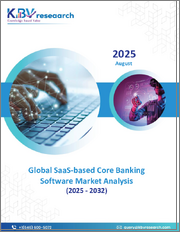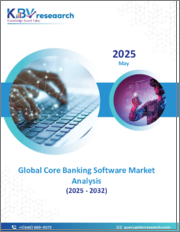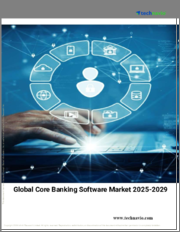
|
시장보고서
상품코드
1528205
세계의 코어 뱅킹 소프트웨어 시장 평가 : 전개 방식별, 최종 사용자별, 컴포넌트별, 뱅킹 유형별, 지역별, 기회, 예측(2017-2031년)Core Banking Software Market Assessment, By Deployment Mode, By End-user, By Component, Banking Type, By Region, Opportunities and Forecast, 2017-2031F |
||||||
세계 코어 뱅킹 소프트웨어 시장 규모는 2023년 150억 8,000만 달러에서 2031년 457억 달러에 이를 것으로 예측되며, 예측 기간인 2024-2031년 CAGR로 14.87%의 성장이 예상됩니다. 기술 발전, 고객 기대, 규제 준수, 비용 효율성, 세계화 및 시장 확대, 데이터 분석, 모바일 뱅킹 이용 증가 등의 요인이 시장 성장으로 이어지는 코어 뱅킹 소프트웨어의 요구를 뒷받침하고 있습니다. 대조적으로, AI의 출현과 AI 기반 뱅킹 시스템의 채택은 예측 기간에 시장 성장에 유익한 기회를 제공할 것으로 예상됩니다.
예를 들어 World Bank는 2024년 2월에 MALENA라는 프로젝트를 시작했습니다. 이것은 AI를 탑재한 플랫폼으로, 신흥 시장의 환경·사회·거버넌스(ESG) 데이터로부터 투자에 관한 지견을 추출합니다. 이 프로젝트는 AI를 활용하여 방대한 데이터를 분석하고 투명성과 의사결정을 강화하여 세계 투자를 지원하는 것을 목표로 하고 있습니다. 이 노력은 뱅킹 시스템에 AI를 통합하여 새로운 기회를 끌어내고 시장 성장을 가속하는 광범위한 동향과 일치합니다.
뱅킹 소프트웨어는 다양한 지점에서 실시간 온라인 거래를 가능하게 함으로써 뱅킹 서비스에 혁명을 가져왔습니다. 이러한 플랫폼을 통해 사용자는 계좌 관리, 거래 및 잔액을 쉽게 모니터링할 수 있습니다. 또한 저널 입력 및 계좌 생성과 같은 중요한 작업을 원활한 업데이트를 가능하게하는 민첩한 아키텍처로 지원하여 현대 은행 업무의 초석이되었습니다. 코어 뱅킹 소프트웨어(CBS)는 은행 기관의 백본 역할을 하며 효율적인 거래 처리, 결제 관리, 재무 기록 관리를 실현합니다. 온라인 뱅킹 기능을 중앙 집중화하여 대출 및 계좌 관리와 같은 서비스에 대한 사용자 액세스를 강화합니다. 시장은 핀테크 기술과 CBS 솔루션에 대한 엄청난 투자로 견인되었으며, 합리화된 고객 계좌 관리와 안전한 디지털 뱅킹 경험에 대한 수요 증가를 반영합니다. 이는 지속적으로 뛰어난 서비스를 유지하기 위한 적응성이 높은 소프트웨어 솔루션의 중요성을 강력하게 보여줍니다.
AI 기반 뱅킹 시스템 채택 증가로 시장 성장 촉진
클라우드 컴퓨팅, 빅데이터 애널리틱스, AI와 같은 새로운 기술의 도입은 은행의 업무 방식을 바꾸어 보다 효율적이고 고객 친화적인 것으로 하고 있습니다. AI를 활용한 혁신은 은행이 데이터를 시각화하고 고객의 문의에 즉시 대응하며 매우 복잡한 데이터를 의미 있는 지식으로 변환할 수 있도록 지원합니다. Nanjing University of Information Science and Technology를 통해 발표된 연구에 따르면 은행 전문가는 비즈니스 분석과 전략적 의사결정을 AI 주도의 출력에 의존하고 있습니다. AI가 주도하는 채팅봇과 디지털 어시스턴트는 끊임없이 원활한 고객 지원을 보장하기 위해 은행의 핵심 시스템의 필수적인 부분이 되었습니다. 이러한 시스템은 실시간으로 문제를 해결하고 전반적인 고객 경험을 향상시킬 뿐만 아니라 문제를 해결합니다. AI 기반 코어 뱅킹 소프트웨어가 제공하는 실시간 발견은 네트워크 보안을 강화하고 디지털 변환을 가속화합니다. 이러한 기술의 채용이 급증하는 가운데, 더욱 중요한 성장 기회가 열릴 것으로 예측됩니다. 뱅킹의 미래는 AI 활용과 밀접하게 연결되어 있습니다. 따라서 업계의 주요 기업들은 혁신적인 AI 솔루션을 향해 전략적 제휴를 맺고 있습니다. 2023년 10월, Sopra Banking Software는 최초의 AI 지원 코어 뱅킹 시스템을 SaaS로 발표했습니다.
이 보고서는 세계 코어 뱅킹 소프트웨어 시장에 대한 조사 분석을 통해 시장 규모와 예측, 시장 역학, 주요 기업 현황과 전망 등의 정보를 제공합니다.
목차
제1장 프로젝트의 범위와 정의
제2장 조사 방법
제3장 주요 요약
제4장 고객의 목소리
- 소프트웨어 및 시장 정보
- 구매 결정에서 고려되는 요소
- 데이터 프라이버시 고려
제5장 세계의 코어 뱅킹 소프트웨어 시장 전망(2017-2031년)
- 시장 규모의 분석과 예측
- 금액
- 시장 점유율 분석과 예측
- 전개별
- 최종 사용자별
- 컴포넌트별
- 뱅킹 유형별
- 지역별
- 시장 점유율 분석 : 기업별(금액)(상위 5개사 및 기타 - 2023년)
- 시장 맵 분석(2023년)
- 전개별
- 최종 사용자별
- 컴포넌트별
- 뱅킹 유형별
- 지역별
제6장 북미의 코어뱅킹 소프트웨어 시장 전망(2017-2031년)
- 시장 규모의 분석과 예측
- 금액
- 시장 점유율 분석과 예측
- 전개별
- 최종 사용자별
- 컴포넌트별
- 뱅킹 유형별
- 점유율 : 국가별
- 시장 평가: 국가별
- 미국의 코어뱅킹 소프트웨어 시장 전망, 2017-2031년 예측
- 캐나다
- 멕시코
제7장 유럽의 코어 뱅킹 소프트웨어 시장 전망(2017-2031년)
- 독일
- 프랑스
- 이탈리아
- 영국
- 러시아
- 네덜란드
- 스페인
- 터키
- 폴란드
제8장 아시아태평양의 핵심뱅킹 소프트웨어 시장 전망(2017-2031년)
- 인도
- 중국
- 일본
- 호주
- 베트남
- 한국
- 인도네시아
- 필리핀
제9장 남미의 코어뱅킹 소프트웨어 시장 전망(2017-2031년)
- 브라질
- 아르헨티나
제10장 중동 및 아프리카의 코어뱅킹 소프트웨어 시장 전망(2017-2031년)
- 사우디아라비아
- 아랍에미리트(UAE)
- 남아프리카
제11장 수급 분석
제12장 밸류체인 분석
제13장 Porter's Five Forces 분석
제14장 PESTLE 분석
제15장 소프트웨어의 가격 분석
제16장 시장 역학
- 시장 성장 촉진요인
- 시장의 과제
제17장 시장 동향과 발전
제18장 사례 연구
제19장 경쟁 구도
- 마켓 리더 상위 5개사의 경쟁 매트릭스
- 상위 5개사의 SWOT 분석
- 주요 기업 상위 10개사의 정세
- Fiserv, Inc.
- Oracle Corporation
- Tata Consultancy Services
- Mambu GmbH
- Capital Banking Solutions
- Finastra International Limited
- HCL Technologies Limited
- FIS(Fidelity National Information Services Inc.)
- Infosys Limited
- Temenos AG
제20장 전략적 추천
제21장 당사에 대하여 면책사항
JHS 24.08.14Global core banking software is projected to witness a CAGR of 14.87% during the forecast period 2024-2031, growing from USD 15.08 billion in 2023 to USD 45.70 billion in 2031. Factors such as technological advancements, customer expectations, regulatory compliance, cost efficiency, globalization and market expansion, data analytics, and increase in the use of mobile banking aids the requirement of a core banking software leading to market growth. On the contrary, the emergence of AI and adoption of an AI-based banking system is expected to provide profitable opportunities for market growth during the forecast period.
For instance, in February 2024, World Bank started a project called MALENA which is an AI-powered platform extracts investment insights from Environmental, Social and Governance (ESG) data in emerging markets. The project aims to support global investments by leveraging AI to analyze vast amounts of data, thereby enhancing transparency and decision-making. This initiative aligns with the broader trend of integrating AI into banking systems to unlock new opportunities and drive market growth.
Banking software have revolutionized banking services by enabling real-time online transactions across various branches. These platforms empower users to effortlessly manage their accounts, conduct transactions, and monitor balances. They serve as the cornerstone of modern banking operations, supporting crucial tasks such as journal entries and account creation with agile architecture for seamless updates. Core Banking Software (CBS) acts as the backbone of banking institutions, ensuring efficient transaction processing, payment management, and financial record-keeping. It offers centralized online banking capabilities, enhancing user access to services like loans and account management. The market is driven by substantial investments in fintech technologies and CBS solutions, reflecting a growing demand for streamlined customer account management and secure digital banking experiences. This underscores the importance of adaptable software solutions in maintaining continuous service excellence.
Increasing Adoption of Artificial Intelligence-based Banking Systems Promotes Market Growth
The infusion of newer technologies, such as cloud computing, big data analytics, and artificial intelligence, is altering the way banks operate, making them more efficient and customer friendly. AI-driven innovations assist banks in visualizing data, respond to customer queries almost in a jiffy, and convert highly complex data into meaningful insights. According to a study published through Nanjing University of Information Science and Technology, banking professionals are dependent on AI-driven output for some robust business analysis and strategic decision-making. AI-driven chatbots and digital assistants have become an intrinsic part of the core banking system in ensuring constant and seamless customer support. These systems troubleshoot in real-time, addressing issues besides elevating the overall customer experience. Real-time insights provided by AI-based core banking software enhance network security and speed up digital transformation, hence improving service delivery, increasing consumer satisfaction. With the surging adoption of such technologies, more key growth opportunities are expected to open. The future of banking is closely linked to harnessing artificial intelligence. As such, critical industry players have been entering into strategic collaborations for innovative AI solutions. In October 2023, Sopra Banking Software launched the First AI-Enabled Core Banking System as a Software-as-a-Service.
Rise in Fintech Drives Growth of Market
Initially, core banking software were merely treated as a supplement to the banking sector. With time, the market has transformed with innovative traditional practices, leading to market growth. Fintech has been able to attract large investments. Large financial markets players, such as Citigroup and JPMorgan Chase & Co., have started strengthening their fintech investments, something that could turn out to be strategic with regard to the adoption of advanced solutions into their operations. The outlook of investors remains quite conservative in the beginning of 2024. In fact, characterized by key concerns such as sustainable profitability, the development prospects for the fintech sector remains robust. It can be more clearly seen in sectors such as community banks that need innovative core banking software to improve operational efficiency. The adoption of these technologies across various banking types, including mid-size banks, small banks, and credit unions, further propels market expansion, fostering a dynamic landscape driven by innovation and digital transformation. In December 2023, Saudi Arabian Buy Now Pay Later Provider deal was closed at USD 340 million funding round. The deal, which made the company the first homegrown FinTech unicorn in Saudi Arabia, was raised through a Series C round.
North America Dominated the Market Due to Innovations
North America dominated the share of the global core banking software market. The region has a history of being early technology adopters. In February 2023, Arvest Bank introduced its inaugural cloud-based equipment financing product, exemplifying the region's progressive approach. The focus on modernizing core infrastructure among major regional banks is set to bolster regional growth. Concurrently, small and medium-sized enterprises in the region are increasingly leveraging these advanced solutions to facilitate seamless financial operations. This trend, coupled with expanding business scopes and applications, is poised to accelerate market growth in the forecast period.
Meanwhile, Asia-Pacific is anticipated to experience the most rapid growth during the forecast period. The uptake of mobile and web-based banking applications is driving the growth along with efforts by regional banks to enhance transaction processing capabilities and uninterrupted banking services through advanced core banking systems.
On-premises Deployment Dominated the Global Core Banking Software Market Share
The on-premises segment dominated the market in 2023. By building an on-premise solution, companies take full responsibility for the integration, IT-related problems, and security involved. Companies that work over legacy platforms are mostly in collaboration with IT professionals to recover data from security threats and control operation costs incurred. Most of the traditional banks use on-premises solutions due to the established infrastructure and keeping control of the security of the data. These are located in the bank's own servers at their premises, which are better protected compared to cloud computing infrastructure. On-premises data centers require hands-on hardware and software maintenance. Software on-premises requires an enterprise to buy a license or copy of the software for use in-house. The software resides wholly within the premises of the organization, generally better protected compared with cloud computing infrastructure. However, the on-premises solution may be very expensive compared to a cloud computing environment, as it is inclined more toward in-house server hardware and software licenses with integration capabilities, apart from requiring dedicated IT staff for support and management in case of any issues in the solution. However, the trend is slowly shifting toward hybrid models that combine both on-premises and cloud-based systems.
Future Market Scenario (2024 - 2031F)
AI will push banks to create greater products that meet basic client demands with the least amount of people involved, right from providing information on savings suggestions to expenditure analysis. AI can furnish banks with information on goods and services, profit margins, and expenses.
The credibility of AI solutions poses a significant concern that must be effectively managed to secure widespread acceptance of AI within the banking sector. It is imperative that all stakeholders in the banking industry actively collaborate to promote the responsible adoption of AI.
Regulators will be more proactive in enforcing policies to safeguard the transparency of AI algorithms, eliminate bias, protect data privacy, and guarantee fair use of customer information. Likewise, banks and service providers will ensure responsible use of AI rather than focusing on the economic gain derived from the innovation.
More banks will be shifting towards the hybrid model of deployment to enable the cost benefits of cloud model and to ensure data privacy.
Key Players Landscape and Outlook
The global core banking software market is highly competitive, with several key players driving innovation and growth. The core banking software market is expected to grow significantly over the next decade, driven by factors such as technological advancements, increasing customer expectations, regulatory compliance, and the need for cost efficiency. The adoption of AI, cloud computing, and data analytics is transforming the landscape, enabling banks to offer more personalized and efficient services.
In April 2024, Fiserv, the US-based fintech and financial services company, wanted to expand its business in India, the biggest market in Asia-Pacific. It plans to launch its payment solution product, Clover, as per the announcement made by the President of Global Services and Global Practice Leader for Implementations at Fiserv.
In February 2024, Capital Bank received the "Best Implementation of Core Banking Services" award from IBS Intelligence in 2023, marking a significant achievement in the year. The award specifically highlights how the bank utilized Temenos' core banking solutions to launch a transformative project aimed at upgrading its core banking system.
Table of Contents
1. Project Scope and Definitions
2. Research Methodology
3. Executive Summary
4. Voice of Customer
- 4.1. Software and Market Intelligence
- 4.2. Factors Considered in Purchase Decisions
- 4.2.1. Brand Name
- 4.2.2. IT Infrastructure Compatibility
- 4.2.3. Security Measures
- 4.2.4. After-Sales Support
- 4.2.5. Ease of use
- 4.3. Consideration of Data Privacy
5. Global Core Banking Software Market Outlook, 2017-2031F
- 5.1. Market Size Analysis & Forecast
- 5.1.1. By Value
- 5.2. Market Share Analysis & Forecast
- 5.2.1. By Deployment
- 5.2.1.1. On-premises
- 5.2.1.2. Cloud-based
- 5.2.2. By End-user
- 5.2.2.1. Banks
- 5.2.2.1.1. Retail
- 5.2.2.1.2. Corporate
- 5.2.2.2. Financial Institutions
- 5.2.2.2.1. Treasury
- 5.2.2.2.2. Wealth Management
- 5.2.2.3. Others
- 5.2.2.1. Banks
- 5.2.3. By Component
- 5.2.3.1. Solution
- 5.2.3.2. Service
- 5.2.4. By Banking Type
- 5.2.4.1. Large Banks
- 5.2.4.2. Mid-Size Banks
- 5.2.4.3. Small Banks
- 5.2.4.4. Community Banks
- 5.2.4.5. Credit Unions
- 5.2.5. By Region
- 5.2.5.1. North America
- 5.2.5.2. Europe
- 5.2.5.3. Asia-Pacific
- 5.2.5.4. South America
- 5.2.5.5. Middle East and Africa
- 5.2.6. By Company Market Share Analysis (Top 5 Companies and Others - By Value, 2023)
- 5.2.1. By Deployment
- 5.3. Market Map Analysis, 2023
- 5.3.1. By Deployment
- 5.3.2. By End-user
- 5.3.3. By Component
- 5.3.4. By Banking Type
- 5.3.5. By Region
6. North America Core Banking Software Market Outlook, 2017-2031F*
- 6.1. Market Size Analysis & Forecast
- 6.1.1. By Value
- 6.2. Market Share Analysis & Forecast
- 6.2.1. By Deployment
- 6.2.1.1. On-premises
- 6.2.1.2. Cloud-based
- 6.2.2. By End-user
- 6.2.2.1. Banks
- 6.2.2.1.1. Retail
- 6.2.2.1.2. Corporate
- 6.2.2.2. Financial Institutions
- 6.2.2.2.1. Treasury
- 6.2.2.2.2. Wealth Management
- 6.2.2.3. Others
- 6.2.2.1. Banks
- 6.2.3. By Component
- 6.2.3.1. Solution
- 6.2.3.2. Service
- 6.2.4. By Banking Type
- 6.2.4.1. Large Banks
- 6.2.4.2. Mid-Size Banks
- 6.2.4.3. Small Banks
- 6.2.4.4. Community Banks
- 6.2.4.5. Credit Unions
- 6.2.5. By Country Share
- 6.2.5.1. United States
- 6.2.5.2. Canada
- 6.2.5.3. Mexico
- 6.2.1. By Deployment
- 6.3. Country Market Assessment
- 6.3.1. United States Core Banking Software Market Outlook, 2017-2031F*
- 6.3.1.1. By Deployment
- 6.3.1.1.1. On-premises
- 6.3.1.1.2. Cloud-based
- 6.3.1.2. By End-user
- 6.3.1.2.1. Banks
- 6.3.1.2.1.1. Retail
- 6.3.1.2.1.2. Corporate
- 6.3.1.2.2. Financial Institutions
- 6.3.1.2.2.1. Treasury
- 6.3.1.2.2.2. Wealth Management
- 6.3.1.2.3. Others
- 6.3.1.2.1. Banks
- 6.3.1.3. By Component
- 6.3.1.3.1. Solution
- 6.3.1.3.2. Service
- 6.3.1.4. By Banking Type
- 6.3.1.4.1. Large Banks
- 6.3.1.4.2. Mid-Size Banks
- 6.3.1.4.3. Small Banks
- 6.3.1.4.4. Community Banks
- 6.3.1.4.5. Credit Unions
- 6.3.1.1. By Deployment
- 6.3.2. Canada
- 6.3.3. Mexico
- 6.3.1. United States Core Banking Software Market Outlook, 2017-2031F*
All segments will be provided for all regions and countries covered
7. Europe Core Banking Software Market Outlook, 2017-2031F
- 7.1. Germany
- 7.2. France
- 7.3. Italy
- 7.4. United Kingdom
- 7.5. Russia
- 7.6. Netherlands
- 7.7. Spain
- 7.8. Turkey
- 7.9. Poland
8. Asia-Pacific Core Banking Software Market Outlook, 2017-2031F
- 8.1. India
- 8.2. China
- 8.3. Japan
- 8.4. Australia
- 8.5. Vietnam
- 8.6. South Korea
- 8.7. Indonesia
- 8.8. Philippines
9. South America Core Banking Software Market Outlook, 2017-2031F
- 9.1. Brazil
- 9.2. Argentina
10. Middle East and Africa Core Banking Software Market Outlook, 2017-2031F
- 10.1. Saudi Arabia
- 10.2. UAE
- 10.3. South Africa
11. Demand Supply Analysis
12. Value Chain Analysis
13. Porter's Five Forces Analysis
14. PESTLE Analysis
15. Software Pricing Analysis
16. Market Dynamics
- 16.1. Market Drivers
- 16.2. Market Challenges
17. Market Trends and Developments
18. Case Studies
19. Competitive Landscape
- 19.1. Competition Matrix of Top 5 Market Leaders
- 19.2. SWOT Analysis for Top 5 Players
- 19.3. Key Players Landscape for Top 10 Market Players
- 19.3.1. Fiserv, Inc.
- 19.3.1.1. Company Details
- 19.3.1.2. Key Management Personnel
- 19.3.1.3. Products and Services
- 19.3.1.4. Financials (As Reported)
- 19.3.1.5. Key Market Focus and Geographical Presence
- 19.3.1.6. Recent Developments/Collaborations/Partnerships/Mergers and Acquisition
- 19.3.2. Oracle Corporation
- 19.3.3. Tata Consultancy Services
- 19.3.4. Mambu GmbH
- 19.3.5. Capital Banking Solutions
- 19.3.6. Finastra International Limited
- 19.3.7. HCL Technologies Limited
- 19.3.8. FIS (Fidelity National Information Services Inc.)
- 19.3.9. Infosys Limited
- 19.3.10. Temenos AG
- 19.3.1. Fiserv, Inc.
Companies mentioned above DO NOT hold any order as per market share and can be changed as per information available during research work.


















